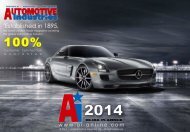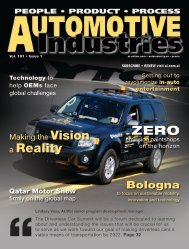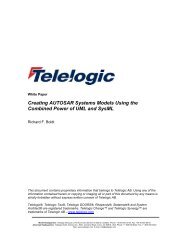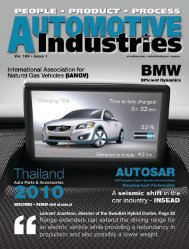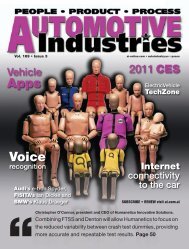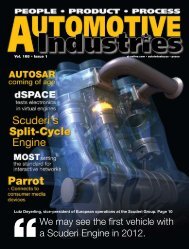engineering, AUTOSAR - Automotive Industries
engineering, AUTOSAR - Automotive Industries
engineering, AUTOSAR - Automotive Industries
You also want an ePaper? Increase the reach of your titles
YUMPU automatically turns print PDFs into web optimized ePapers that Google loves.
MOST –<br />
connecting all five<br />
major fields By: Lenny Case<br />
innovation<br />
In-vehicle use of the MOST standard is reaching critical<br />
mass, with over 100 models on the road fitted with MOST<br />
technology. The newest standard, MOST150, meets the requirements<br />
not only for the traditional areas of entertainment<br />
and information, but also for the new domains of mobile<br />
connectivity, connected services and driver assistance<br />
– meeting the needs of the five major areas of in-car use.<br />
“Today, MOST150 offers the technology and the audio/video<br />
capability for next generation automotive infotainment<br />
features and devices as well as new features like<br />
Internet access devices, video processing units,<br />
and many more. The MOST150 Technology is<br />
ready for production and various car makers<br />
have already started implementing MOST<br />
Technology in their first series projects,<br />
Christian Thiel, spokesperson<br />
for the MOST Cooperation<br />
including Audi and Daimler,” said Christian<br />
Thiel, spokesperson for the MOST<br />
Cooperation in an earlier interview to AI.<br />
The MOST Cooperation was founded<br />
in 1998 to standardize MOST Technology as<br />
a global standard for multimedia networking and<br />
now consists of 16 international vehicle manufacturers<br />
and more than 60 key component suppliers. Audi, BMW, Daimler,<br />
HARMAN and SMSC are its core partners and constitute its<br />
steering committee. It’s success also rides on its associate partners<br />
such as GM, the Hyundai Kia <strong>Automotive</strong> Group, the Toyota Motor<br />
Corporation, the PSA Group, the Ford Motor Company and Alpine.<br />
<strong>Automotive</strong> <strong>Industries</strong> (AI) asked Thiel what the goals of<br />
the November conference in Korea were.<br />
thiel: MOST Cooperation’s Interconnectivity Conference Asia in<br />
South Korea was designed to demonstrate to the Asian automotive<br />
industry that MOST Technology is ready for extended multimedia<br />
and information applications in the vehicle. MOST150 now serves<br />
the five major fields of in-car use by meeting the requirements for<br />
the traditional areas of entertainment and information as well as the<br />
emerging domains of mobile connectivity, connected services and<br />
driver assistance. In the accompanying exhibition, MOST showed<br />
that it supports star, daisy-chain, tree and other topologies, as well<br />
as different physical layers: plastic optical fibers (POF), COAX based<br />
electrical physical layer as well as shielded (STP) and unshielded<br />
twisted pair (UTP) of copper wires. MOST150 also represents a<br />
physical layer for Ethernet with its new Ethernet channel that runs<br />
parallel with all other communication channels provided by MOST.<br />
The Ethernet channel transmits unmodified Ethernet<br />
frames so that software stacks and applications from<br />
the consumer and IT domains can be seamlessly<br />
integrated into automobiles. TCP/IP stacks and<br />
other Ethernet protocols can communicate<br />
over MOST without any changes.<br />
AI: To what extent are MOST standards<br />
globally accepted?<br />
thiel: With the acceptance of<br />
MOST Technology reaching 100 car<br />
models on the road today, MOST has<br />
become a worldwide de facto standard<br />
of the automotive industry. After its initial<br />
start in Europe nine years ago, Asian<br />
carmakers presented their first vehicles<br />
with MOST in 2007 and today there are<br />
over 20 models manufactured by Asian<br />
automakers with MOST built in.<br />
Since MOST Technology is designed to be environmentally<br />
sustainable with reduced weight and electromagnetic<br />
interference, it has been adopted in more than ten hybrid<br />
vehicles to date. The plastic optical fiber (POF) chosen ten years<br />
ago suits the requirements of hybrid and electrical power trains very<br />
well. The use of MOST Technology is expanding rapidly from the<br />
premium range to the high-volume, medium-sized vehicle market<br />
worldwide. Currently, MOST is adopted in approximately 12% of<br />
vehicles manufactured worldwide. Its traditional and new adopters<br />
represent almost 50% of current global light vehicle production.<br />
AI: How would you rate the success of MOST150 and why?<br />
thiel: Adoption of automotive infrastructure technologies takes<br />
many years. For example, it has taken CAN about 20 years to find its<br />
way in nearly all cars produced worldwide. The key success factor is<br />
that MOST has been developed and optimized for the car industry.<br />
26 to read full version of AI stories go to www.ai-online.com




